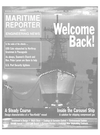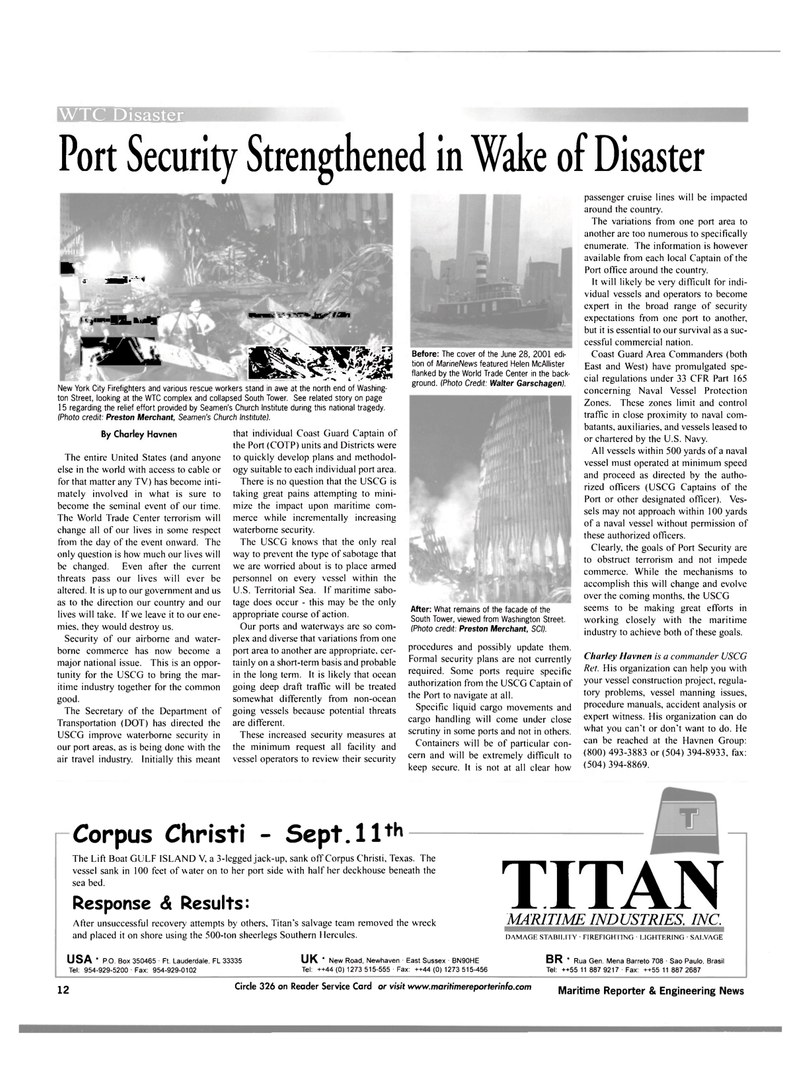
Page 12: of Maritime Reporter Magazine (October 2001)
Read this page in Pdf, Flash or Html5 edition of October 2001 Maritime Reporter Magazine
WTC Disaster
Port Security Strengthened in Wake of Disaster
Ob , ;aaai. - *
Wn * H-Jiyy Jn f . jt w J^fcrsflj' r^sLii
S&i^iii
New York City Firefighters and various rescue workers stand in awe at the north end of Washing- ton Street, looking at the WTC complex and collapsed South Tower. See related story on page 15 regarding the relief effort provided by Seamen's Church Institute during this national tragedy. (Photo credit: Preston Merchant, Seamen's Church Institute).
By Charley Havnen
The entire United States (and anyone else in the world with access to cable or for that matter any TV) has become inti- mately involved in what is sure to become the seminal event of our time.
The World Trade Center terrorism will change all of our lives in some respect from the day of the event onward. The only question is how much our lives will be changed. Even after the current threats pass our lives will ever be altered. It is up to our government and us as to the direction our country and our lives will take. If we leave it to our ene- mies. they would destroy us.
Security of our airborne and water- borne commerce has now become a major national issue. This is an oppor- tunity for the USCG to bring the mar- itime industry together for the common good.
The Secretary of the Department of
Transportation (DOT) has directed the
USCG improve waterborne security in our port areas, as is being done with the air travel industry. Initially this meant that individual Coast Guard Captain of the Port (COTP) units and Districts were to quickly develop plans and methodol- ogy suitable to each individual port area.
There is no question that the USCG is taking great pains attempting to mini- mize the impact upon maritime com- merce while incrementally increasing waterborne security.
The USCG knows that the only real way to prevent the type of sabotage that we are worried about is to place armed personnel on every vessel within the
U.S. Territorial Sea. If maritime sabo- tage does occur - this may be the only appropriate course of action.
Our ports and waterways are so com- plex and diverse that variations from one port area to another are appropriate, cer- tainly on a short-term basis and probable in the long term. It is likely that ocean going deep draft traffic will be treated somewhat differently from non-ocean going vessels because potential threats are different.
These increased security measures at the minimum request all facility and vessel operators to review their security
Before: The cover of the June 28, 2001 edi- tion of MarineNews featured Helen McAllister flanked by the World Trade Center in the back- ground. (Photo Credit: Walter Garschagen).
After: What remains of the facade of the
South Tower, viewed from Washington Street. (Photo credit: Preston Merchant, SCI). procedures and possibly update them.
Formal security plans are not currently required. Some ports require specific authorization from the USCG Captain of the Port to navigate at all.
Specific liquid cargo movements and cargo handling will come under close scrutiny in some ports and not in others.
Containers will be of particular con- cern and will be extremely difficult to keep secure. It is not at all clear how passenger cruise lines will be impacted around the country.
The variations from one port area to another are too numerous to specifically enumerate. The information is however available from each local Captain of the
Port office around the country.
It will likely be very difficult for indi- vidual vessels and operators to become expert in the broad range of security expectations from one port to another, but it is essential to our survival as a suc- cessful commercial nation.
Coast Guard Area Commanders (both
East and West) have promulgated spe- cial regulations under 33 CFR Part 165 concerning Naval Vessel Protection
Zones. These zones limit and control traffic in close proximity to naval com- batants, auxiliaries, and vessels leased to or chartered by the U.S. Navy.
All vessels within 500 yards of a naval vessel must operated at minimum speed and proceed as directed by the autho- rized officers (USCG Captains of the
Port or other designated officer). Ves- sels may not approach within 100 yards of a naval vessel without permission of these authorized officers.
Clearly, the goals of Port Security are to obstruct terrorism and not impede commerce. While the mechanisms to accomplish this will change and evolve over the coming months, the USCG seems to be making great efforts in working closely with the maritime industry to achieve both of these goals.
Cliurley Havnen is a commander USCG
Ret. His organization can help you with your vessel construction project, regula- tory problems, vessel manning issues, procedure manuals, accident analysis or expert witness. His organization can do what you can't or don't want to do. He can be reached at the Havnen Group: (800) 493-3883 or (504) 394-8933, fax: (504) 394-8869.
Corpus Christi - Sept. 11th —
The Lift Boat GULF ISLAND V, a 3-legged jack-up, sank off Corpus Christi, Texas. The vessel sank in 100 feet of water on to her port side with half her deckhouse beneath the sea bed.
Response <& Results:
After unsuccessful recovery attempts by others. Titan's salvage team removed the wreck and placed it on shore using the 500-ton sheerlegs Southern Hercules.
USA • P.O. Box 350465 Ft. Lauderdale, FL 33335
Tel: 954-929-5200 • Fax: 954-929-0102
UK ' New Road, Newhaven East Sussex BN90HE
Tel: ++44 (0) 1273 515-555 • Fax: ++44(0)1273 515-456
TITAN
MARITIME INDUSTRIES, INC.
DAMAGE STABILITY • FIREFIGHTING • LIGHTERING • SALVAGE
BR • Rua Gen. Mena Barreto 708 • Sao Paulo, Brasil
Tel: ++55 11 887 9217 Fax: ++55 11 887 2687 12 Circle 326 on Reader Service Card or visit www.maritimereporterinfo.com Maritime Reporter & Engineering News

 11
11

 13
13
